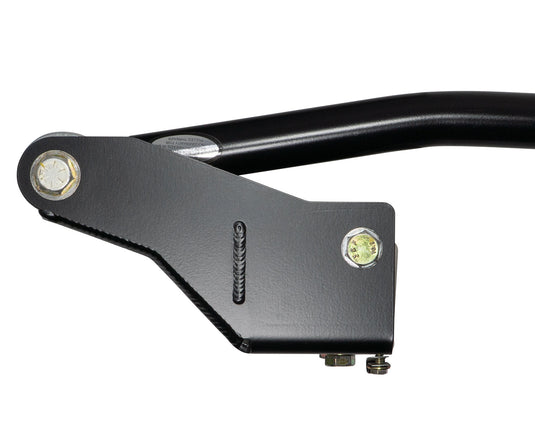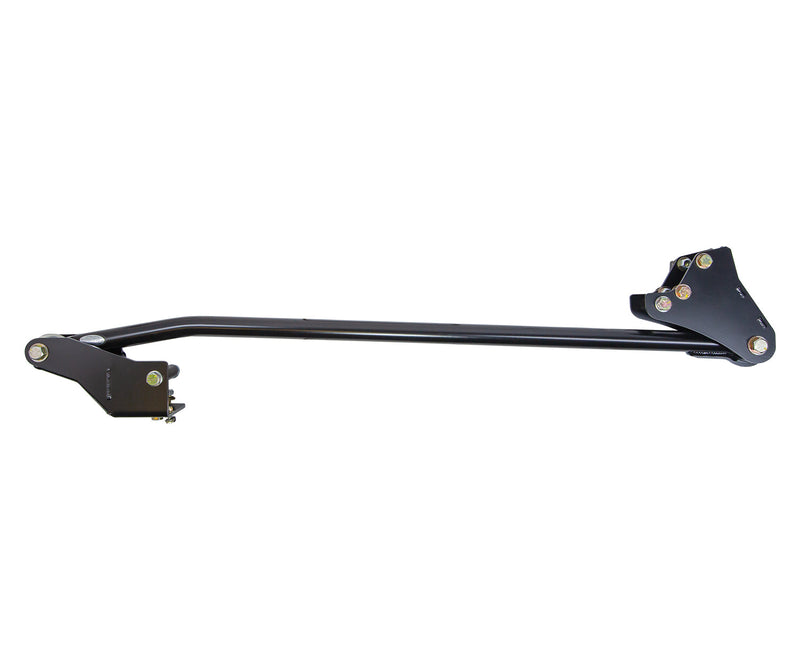
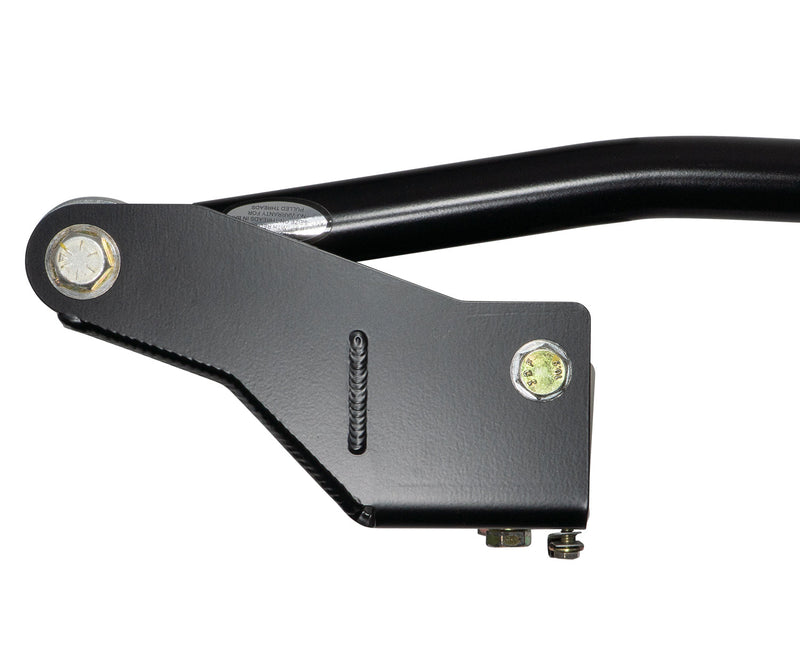
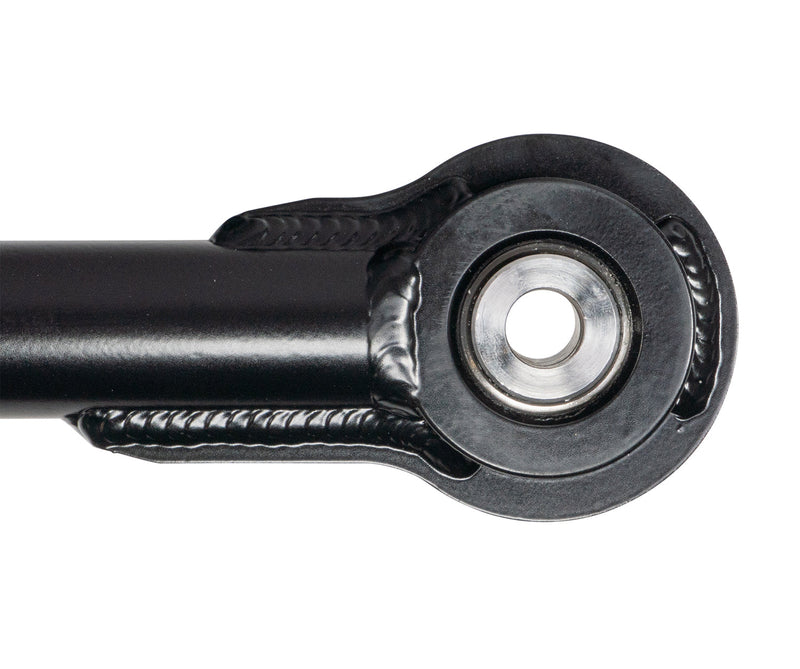

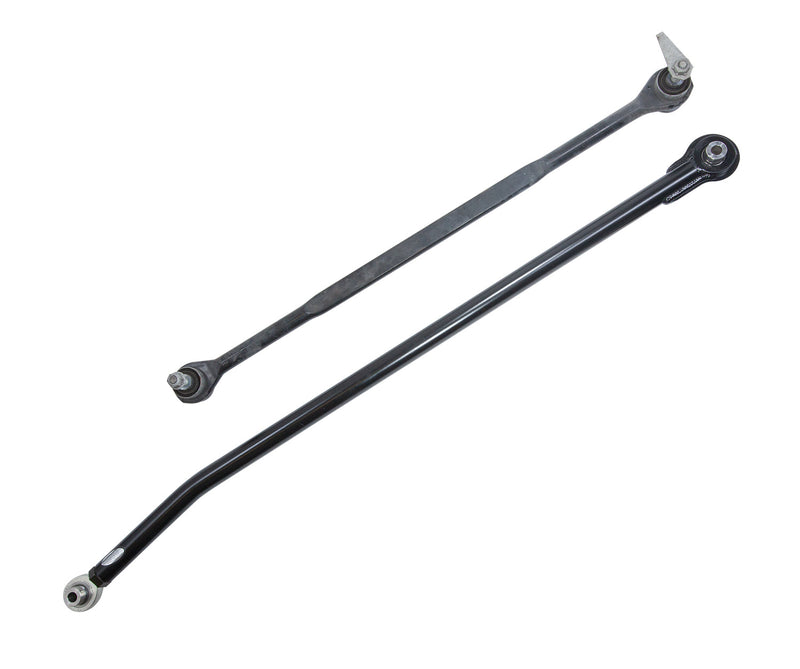

Rams equipped with the 5-link rear suspension offer an unparalleled on and off-road ride quality in both factory, and modified form. Straight off the dealer lot, the small bump compliance and composure of the factory suspension is reminiscent of driving a 1/2-ton. That said, this suspension design comes with it’s share of downfalls. The one we’re addressing with the Carli Extended Rear Track Bar is, as the name would imply, the length of the factory track bar.
SKU: CS-DATB-14-R-KIT
– 13.8″ Longer Than the Factory Rear Track Bar
– Ideal Roll Center
– Eliminates Rear “Yaw” (lateral wag of rear end)
– NVH Isolated PTFE FK Bearings Maximize Service Life
– Fitment: Ram 2500 4×4
– Fits Carli 3.25″ System, 2.5″ Kits Require 1″ Bump Drop: CS-DRBD-AL
– Power Wagon Requires: CS-DATB-14-R-PWHK
The suspension is designed with 4 trailing arms maintaining the rear axle’s vertical, fore, and aft movement while the lateral axle movement is controlled by a track bar. This track bar attaches to the frame on the passenger side and axle on the driver’s side. This opposes the front track bar that’s mounted to the frame on the driver’s side and axle on the passenger’s side. These opposing track bar mounting provisions cause the chassis to twist over the axles as the suspension cycles through it’s travel. When the truck is suspended on a rack, springs removed – it’s easy to see how the axle shift side to side as they travel through the shock stroke. In the real world, the tires are planted on the pavement (or dirt); their traction means the body shifts as the suspension cycles. This body movement (rotation of the vehicle around its vertical axis) is referred to as yaw. The more linear the axle’s path through the travel stroke, the less “yaw” will be encountered.
There are two ways to mitigate the lateral movement of an axle with a track bar. First, lengthen the bar itself. The lateral movement that’s felt, in cab, is the effective shortening of the track bar. The track bar will pivot around it’s fixed mounting hardware. The frame bolt is static; the track bar is at it’s longest when it’s perfectly flat. It’s shortest when at it’s most extreme angle. The effective length and drastic angle change through travel is what’s felt as in-cab yaw. Extending the length of bar itself, spacing the pivots further away from each other, will lessen the effective length AND angle change through the same stroke of travel.
With the bar as long as possible, flattening it at its center-point in travel (ride-height) will present the least deviation from it’s longest to it’s shortest effective length. Most miles are spent on the highway or around town; even light offroad. For this driving, the suspension will live in the middle 50% of it’s travel. It’s within this middle 50% that the side to side movement of the rear axle should be the least. To accomplish this, we designed the longest bar on the market – a whopping 13.8″ longer than the factory bar – then lifted the axle end and lowered the frame end to ensure the bar pivots were level at ride height. The result is a track bar that effectively disappears in the rear. There’s no detectable rear yaw on a truck with the Carli Rear track bar. In analyzing the extremes of travel, you’ll see the most deviation – given the amount of movement in the suspension when encountering obstacles large enough to reach these travel extremes, the lateral shift was still undetectable and, at it’s most, the Carli track bar saw 5/8″ of shortening.
In short, we addressed the transverse movement of the axle by flattening the bar through an axle-side lift and frame-side drop, and drastically increasing the length of the bar equally on both sides to minimize angle of the bar through the travel stroke while perfecting the roll-center.
Rams equipped with the 5-link rear suspension offer an unparalleled on and off-road ride quality in both factory, and modified form. Straight off the dealer lot, the small bump compliance and composure of the factory suspension is reminiscent of driving a 1/2-ton. That said, this suspension design comes with it’s share of downfalls. The one we’re addressing with the Carli Extended Rear Track Bar is, as the name would imply, the length of the factory track bar.
SKU: CS-DATB-14-R-KIT
– 13.8″ Longer Than the Factory Rear Track Bar
– Ideal Roll Center
– Eliminates Rear “Yaw” (lateral wag of rear end)
– NVH Isolated PTFE FK Bearings Maximize Service Life
– Fitment: Ram 2500 4×4
– Fits Carli 3.25″ System, 2.5″ Kits Require 1″ Bump Drop: CS-DRBD-AL
– Power Wagon Requires: CS-DATB-14-R-PWHK
The suspension is designed with 4 trailing arms maintaining the rear axle’s vertical, fore, and aft movement while the lateral axle movement is controlled by a track bar. This track bar attaches to the frame on the passenger side and axle on the driver’s side. This opposes the front track bar that’s mounted to the frame on the driver’s side and axle on the passenger’s side. These opposing track bar mounting provisions cause the chassis to twist over the axles as the suspension cycles through it’s travel. When the truck is suspended on a rack, springs removed – it’s easy to see how the axle shift side to side as they travel through the shock stroke. In the real world, the tires are planted on the pavement (or dirt); their traction means the body shifts as the suspension cycles. This body movement (rotation of the vehicle around its vertical axis) is referred to as yaw. The more linear the axle’s path through the travel stroke, the less “yaw” will be encountered.
There are two ways to mitigate the lateral movement of an axle with a track bar. First, lengthen the bar itself. The lateral movement that’s felt, in cab, is the effective shortening of the track bar. The track bar will pivot around it’s fixed mounting hardware. The frame bolt is static; the track bar is at it’s longest when it’s perfectly flat. It’s shortest when at it’s most extreme angle. The effective length and drastic angle change through travel is what’s felt as in-cab yaw. Extending the length of bar itself, spacing the pivots further away from each other, will lessen the effective length AND angle change through the same stroke of travel.
With the bar as long as possible, flattening it at its center-point in travel (ride-height) will present the least deviation from it’s longest to it’s shortest effective length. Most miles are spent on the highway or around town; even light offroad. For this driving, the suspension will live in the middle 50% of it’s travel. It’s within this middle 50% that the side to side movement of the rear axle should be the least. To accomplish this, we designed the longest bar on the market – a whopping 13.8″ longer than the factory bar – then lifted the axle end and lowered the frame end to ensure the bar pivots were level at ride height. The result is a track bar that effectively disappears in the rear. There’s no detectable rear yaw on a truck with the Carli Rear track bar. In analyzing the extremes of travel, you’ll see the most deviation – given the amount of movement in the suspension when encountering obstacles large enough to reach these travel extremes, the lateral shift was still undetectable and, at it’s most, the Carli track bar saw 5/8″ of shortening.
In short, we addressed the transverse movement of the axle by flattening the bar through an axle-side lift and frame-side drop, and drastically increasing the length of the bar equally on both sides to minimize angle of the bar through the travel stroke while perfecting the roll-center.


